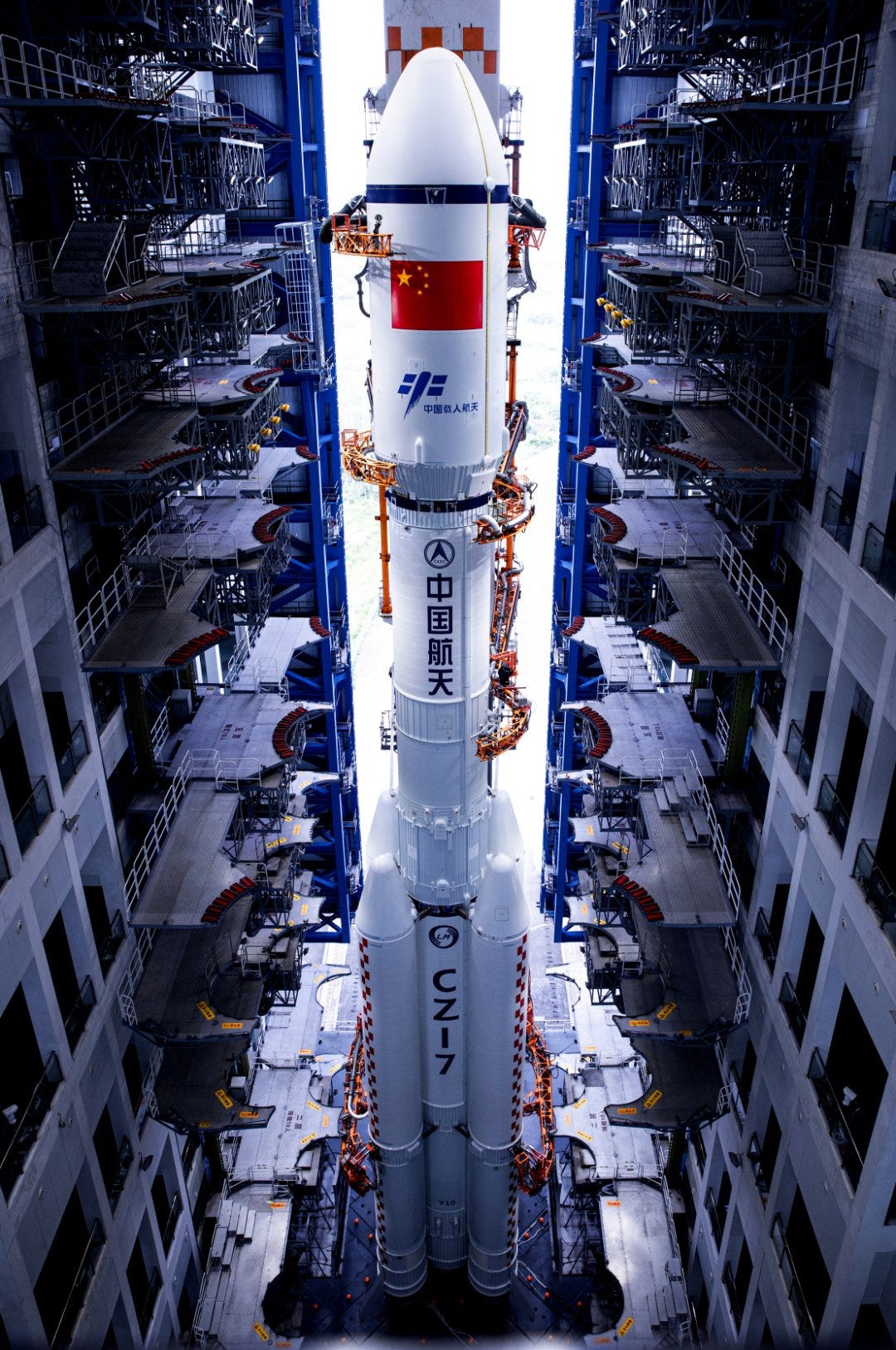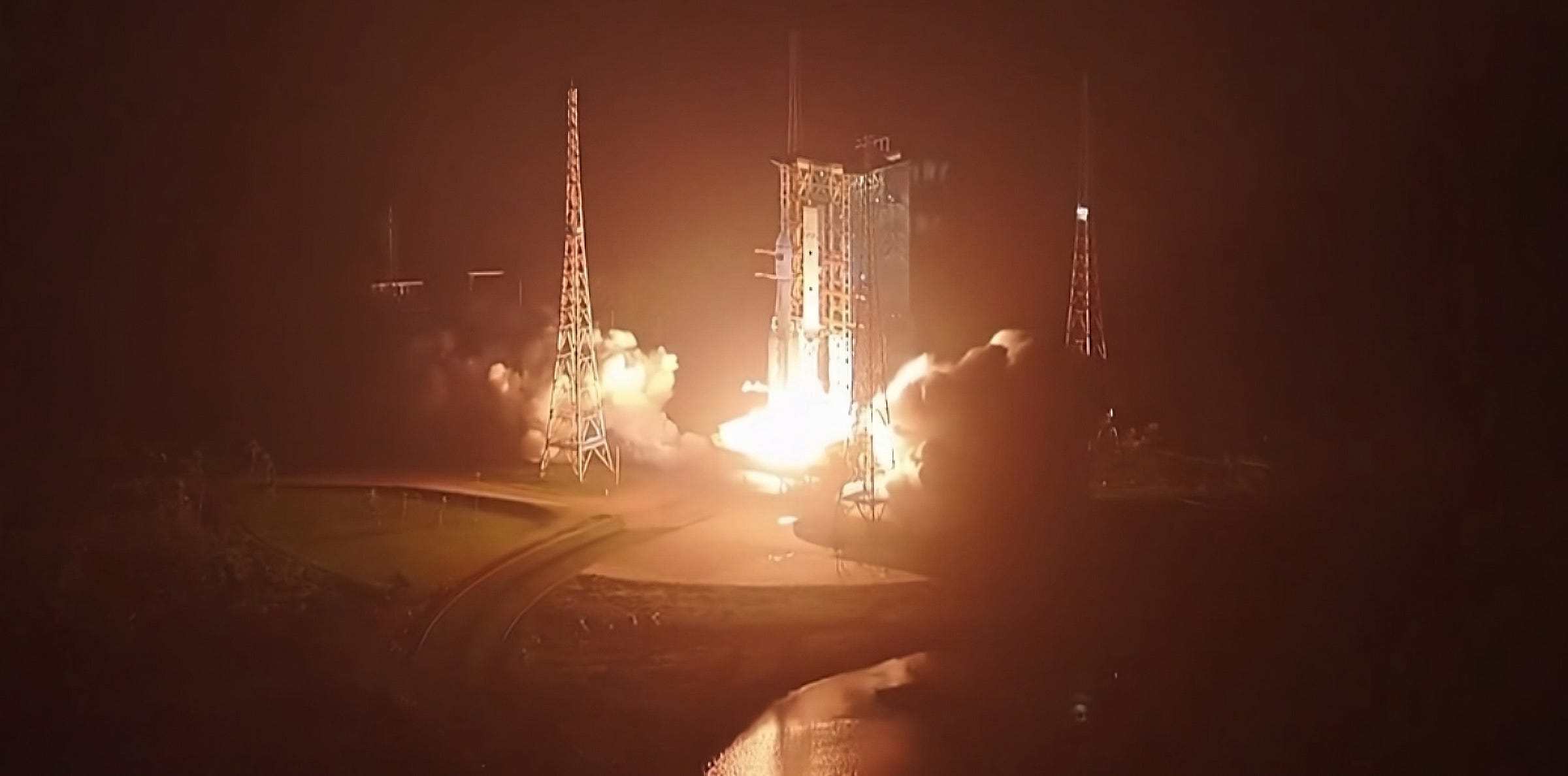Tianzhou-9 Resupply Mission Blasts Off! [Long March 7 Y10]
New spacesuits and experiments are headed for Tiangong.
From Launch Complex 201 at the Wenchang Space Launch Site, a Long March 7 blasted off at 05:34 am China Standard Time on July 15th (21:34 Universal Coordinated Time on July 14th) heading for low Earth orbit.
Atop of the rocket was the Tianzhou-9 cargo resupply mission, which is now chasing down the Tiangong Space Station to dock at the Tianhe module’s aft port (estimated to occur around three hours after launch). The Tianzhou (天舟) spacecraft, making its eighth visit to the space station, is an uncrewed autonomous cargo spacecraft developed by the China Aerospace Science and Technology Corporation and its subsidiaries to bring supplies to the Tiangong Space Station.
Tianzhou’s design is derived from China’s first space stations, Tiangong-1 and Tiangong-2, and is capable of delivering 7,400 kilograms of cargo to their space station and weighs 14,000 kilograms. The total volume of cargo can be up to forty cubic meters, depending on configuration (pressurized, semi-pressurized, and unpressurized). Propelling the spacecraft during orbital maneuvers are four engines generating approximately 200 kilograms of thrust, while two solar panel wings generate electrical power.
6,500 kilograms of cargo is loaded onboard Tianzhou-9, including food and other consumables for Chen Dong (陈冬), Chen Zhongrui (陈中瑞), and Wang Jie (王杰) currently onboard for Shenzhou-20 and the future Shenzhou-21 crews, alongside scientific experiments that will be performed over the next few months and years. Propellants to refuel Tiangong’s maneuvering and attitude control thrusters are set to be delivered too. Two new and improved Feitian (飞天航天服) spacesuits are also being delivered, as spacesuits used as recently as late June have undergone operational life extensions for use beyond their initial design life, along with improvements for microgravity exercise equipment.
Update: At 08:52 am China Standard Time (00:52 am Universal Coordinated Time) on July 15th, Tianzhou-9 docked with Tiangong. Shortly afterwards, the Shenzhou-20 crew entered the cargo spacecraft.
At the moment, the Tianzhou-9 spacecraft is planned to remain docked to Tiangong in March 2026.

Before launch, the rocket and spacecraft were rolled out on July 12th, and the following day, launch rehearsals and final pre-flight tests of Tianzhou-9 and the Long March 7 occurred on July 13th, verifying the rocket was ready and safe to launch. The launch rehearsals were extensive and ran up to moments before ignition.
Between its missions, various improvements to the Long March 7’s operations were made, like testing and quality control processes. Alongside this, the testing time for the Tianzhou-9 spacecraft was optimized to 25 days, from 27 days. Additionally, it is said that the window for the launch was over two minutes thanks to improvements to the rocket. Extensive support was also provided to many personnel working on the mission too.
With the more recent Tianzhou missions, the spacecraft and its systems are being mass-produced to support space station missions in the coming years. Thanks to improvements in the production rate of Tianzhou cargo spacecraft, today’s and future resupply missions are ready in an emergency support state. This has the spacecraft ready to quickly respond to the needs of the Tiangong Space Station within three months.
Today’s launch was the 10th mission for the Long March 7, the 20th launch of the Long March 7 series (consisting of the Long March 7 and 7A), and the 584th launch of the Long March launch vehicle series. This was also the 38th launch from China in 2025.
Check out the previous Long March 7 launch
Tianzhou-8 heads for Tiangong! [Long March 7 Y9]
The seventh cargo resupply mission blasted off from Launch Complex 201 at the Wenchang Space Launch Site atop of a Long March 7 on November 15th. Liftoff occurred at 23:13 pm China Standard Time, or 15:13 pm Universal Coordinated …
What is the Long March 7?
This section is for those less familiar with China's Long March series of launch vehicles.
The Long March 7, developed by the China Academy of Launch Vehicle Technology, is a key part of China's crewed space efforts and launches at least one Tianzhou spacecraft each year. This vehicle utilizes a two-and-a-half-stage design and is fuelled by rocket-grade kerosene and liquid oxygen in its boosters, first, and second stages.
The payload capacity of the launch vehicle is currently as follows:
14,00 kilograms to Low Earth orbit

The Long March 7's first stage is equipped with two YF-100 engines that produce 245 tons of thrust using rocket-grade kerosene and liquid oxygen, complemented by four boosters, each with a YF-100 engine generating 122 tons of thrust, resulting in a combined thrust of approximately 733 tons. The second stage is powered by four YF-115 engines, which together generate 72 tons of thrust using the same fuel combination.
On the launchpad, the Long March 7 stands at 53.1 meters tall and weighs 597,000 kilograms when fully fuelled. The first and second-stage have a diameter of 3.35 meters, the four boosters are 2.25 meters in diameter, and the fairing has a diameter of 4.2 meters.
So far the Long March 7 has only flown from the Wenchang Space Launch Site, on the east coast of Hainan province.





![Tianzhou-8 heads for Tiangong! [Long March 7 Y9]](https://substackcdn.com/image/fetch/$s_!RlOP!,w_1300,h_650,c_fill,f_auto,q_auto:good,fl_progressive:steep,g_auto/https%3A%2F%2Fsubstack-post-media.s3.amazonaws.com%2Fpublic%2Fimages%2Fd668c496-3ee2-4cc3-958c-b99ce464f4a8_1877x1160.jpeg)